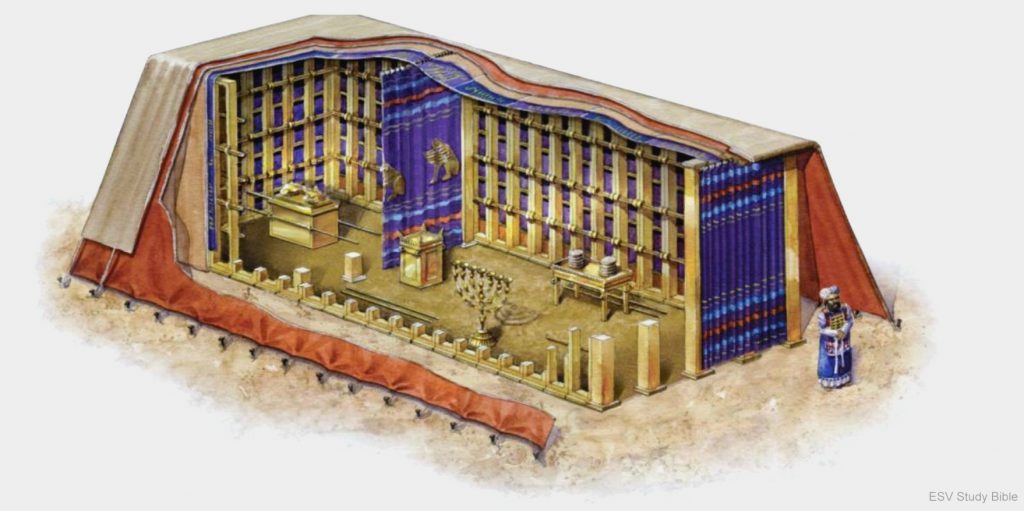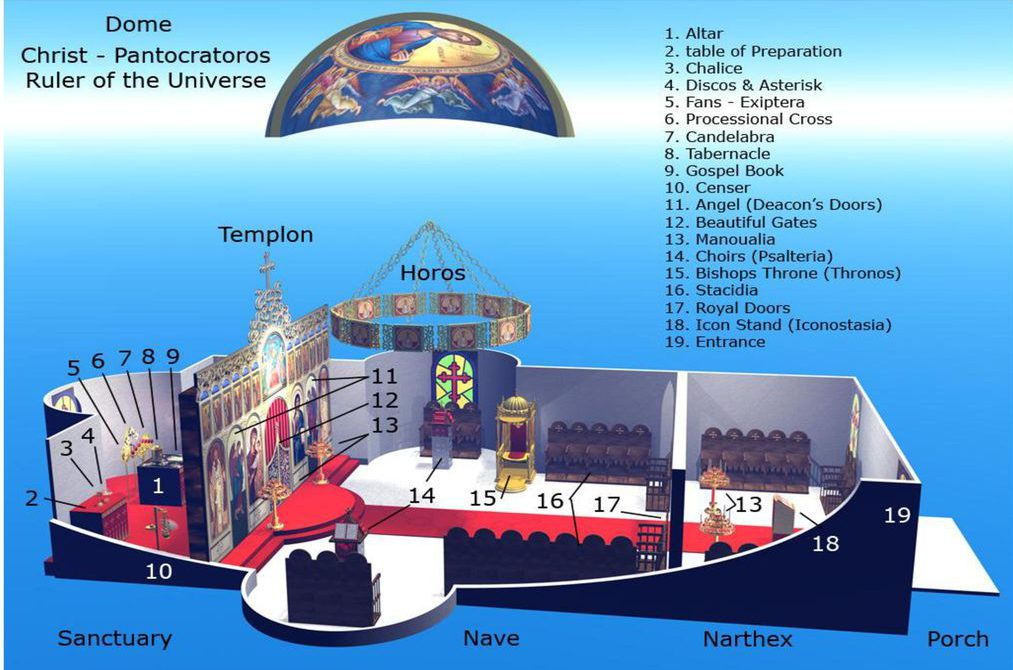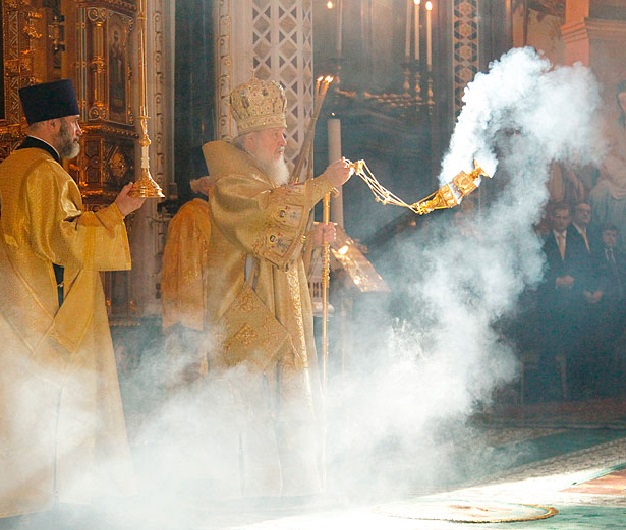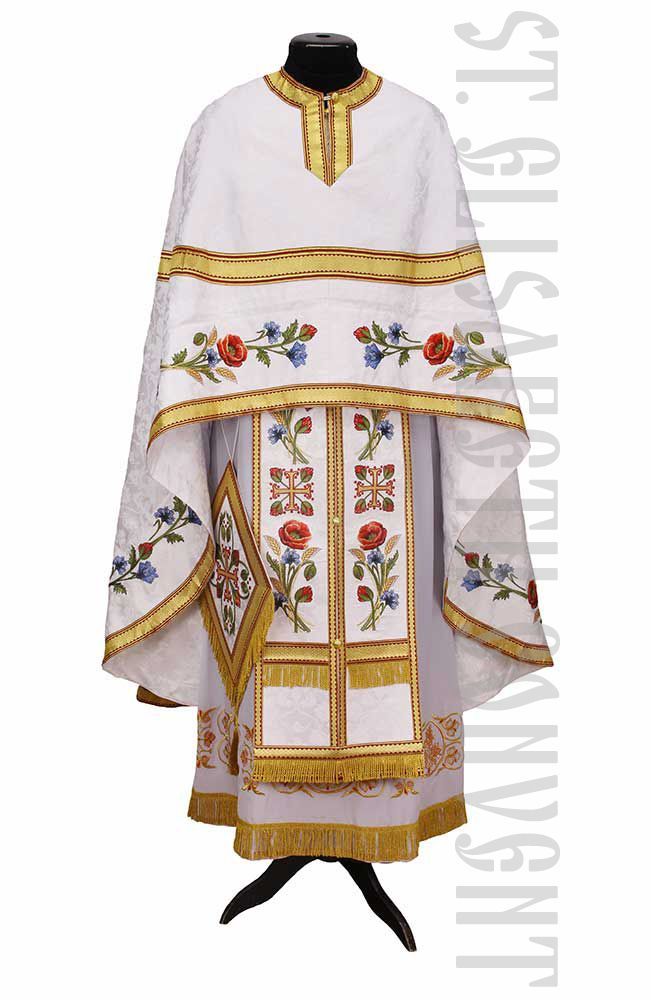When someone unfamiliar with the Orthodox Church attends a service for the first time, it can be overwhelming. The sights, the sounds, the smells… All of it goes against what they are used to: praise bands, Jumbotrons, hour-long sermons, and buildings that resemble auditoriums instead of temples. This kind of worship is so popular in America, mostly because the services are fun and exciting and easy to understand. Because they make people feel good. Orthodox worship could not look more different from the contemporary approach of Protestant churches. And for good reason: Orthodox worship is patterned after worship in the Bible!
In this post, we’ll explore the different elements of Orthodox worship and connect them to Scripture.
Estimated reading time: 13 minutes
Table of contents
We must worship “according to the pattern”
The false belief that lies at the root of the contemporary worship concerts we see these days is that there is no guiding principle for worship in the Bible. This is curious, especially considering how well Protestant Christians know the Scriptures. There is, indeed, a guiding principle for how we are to worship God: we should worship according to the pattern.
Saint Stephen, the first martyr, notes in his sermon that Old Testament worship was “according to the pattern” Moses had seen (Acts 7:44). We also see this phrase in Hebrews 8:5. “According to the pattern” is a reference to Exodus 24:15-18, when Moses goes up on Mt. Sinai for forty days and forty nights. While in the direct presence of God on the mountain, Moses received instructions about how to order the life of the new Jewish nation. He wasn’t told to ever improvise or adapt to contemporary culture; instead, the Lord told him to imitate the heavenly worship.
What is the pattern?
In Exodus 25 to 31, Moses receives instruction concerning the construction of the Ark of the Covenant, the Tabernacle, the lamp stand, the altar for burnt offerings, the altar for incense, the anointing oil, the vestments for the priests, and the consecration of the priests. We see “according to the pattern” repeated several times in the design specifications for the Tabernacle (Exodus 25:8, 25:40, 26:30, 27:8). This shows that God expected His people to worship Him in the prescribed manner, not in whatever way they thought resonated with them or was “in vogue” with the culture of their time. Proper worship meant keeping to this pattern. And to be God’s people, they needed to worship Him properly. In other words, this proper worship was a key part of their identity in their covenant with God. So it stands to reason that proper worship is also key to our identity as Christians.
By studying how worship was defined in the Old Testament and comparing it with the Orthodox liturgy, we can better understand why Orthodox worship is the way it is and how contemporary worship has strayed far from biblical worship.
Orthodox worship follows the pattern
Note:
Despite clear instructions from God, the Israelites struggled to follow the biblical pattern of worship set out for them. We see how the idolatrous pagan nations tempt them throughout the Old Testament, and we see the people fall into sin many times. Just a few examples of their struggles can be found in Exodus 32, II Kings 12:25-33, II Chronicles.
From their struggles, we should realize that proper worship is necessary to have a right relationship with God. This truth does not change just because we are Christian and not “Jewish” anymore.
Orthodox worship follows the pattern of Old Testament worship in several ways. In the next sections, we take a look at each of them a bit more in depth.
- Layout of the temple
- Holy images
- Heavenly worship
- Incense
- Priests
- Vestments
The layout of Orthodox temples
Orthodox churches usually have three main areas: the narthex (entry room), the nave (body of the temple), and the altar area. These areas all mirror the Outer Court, the Holy Place, and the Most Holy Place, respectively (Exodus 26:30-37, 27:9-19; I Kings 6:14-36; II Chronicles 3 and 4).


Note the many similarities between the first and second image. Structurally, the Orthodox Church strives to worship according to the pattern of Old Testament worship.
Notice how in both temples, a partition separates the nave/Holy Place from the altar/Most Holy Place? The wall of sacred images in Orthodox churches – the iconostasis – mirrors the curtain of the Temple (Exodus 26:31-33; I Kings 6:31-35). Further, both altars were used to offer sacrifices; except the kind of sacrifice changed. While the Jewish high priests offered sacrifices in the Most Holy Place, Orthodox priests offer up the spiritual sacrifice of Christ’s body and blood at the altar.
Holy images
In our churches, you will often see holy images of Christ, the Theotokos, angels, and the Saints. Contrary to what most Western Christians believe, this is not idolatry. In fact, having holy images in the temple goes according to the pattern of worship prescribed for the Israelites, who carved images of angels, trees, and flowers on the temple walls (I Kings 6:29; II Chronicles 3:5-7).
Heavenly worship
Orthodox worship is also patterned after the worship in heaven. At the start of the second half of the Divine Liturgy the church sings:
Holy, Holy, Holy, Lord of Hosts, heaven and earth are full of your glory. Hosanna in the highest. Blessed is he who comes in the name of the Lord. Hosanna in the highest.
This is a participation of the heavenly worship described in Isaiah 6:3 and Revelation 4:8. For the Orthodox Church this point of the Divine Liturgy is not so much an imitation as a participation in the heavenly worship.
Incense
Incense was not only part of Old Testament worship, but also of worship in heaven. In his vision of God, Isaiah describes how as the angels sang: “Holy, Holy, Holy” the doors shook and the temple in heaven was filled with incense (Isaiah 6:4). Likewise, the Apostle John in Revelation describes how the angels in heaven held bowls full of incense and how the heavenly Temple was filled with its smoke (Revelation 5:8, 8:3-4, 15:8). Additionally, the prophet Malachi confirms the presence of incense in the worship of God in the Messianic Age (1:11). Whereas before incense was offered in the Jerusalem Temple, in the Messianic Age incense would be offered by the Gentiles, or non-Jews.

The use of incense was an integral part of Old Testament worship and is one of the key markers of authentic biblical worship in the Messianic Age.
Gentile priests
Historically the Christian Church has recognized the offices of deacons, priests, and bishops. The practice of an ordained clergy has roots in the New Testament Church (Acts 1:20; see also I Timothy 5:17-22, II Timothy 2:2). Continuing this practice, the Orthodox Church has ordained priests who serve at the altar and lead the congregation in prayer. The prophet Isaiah foretells the important role that Gentiles would play in the rebuilding of the New Israel, the Church:
And they shall rebuild the old ruins,
Isaiah 61:4-6
They shall raise up the former desolations,
And they shall repair the ruined cities
The desolations of many generations.
Strangers shall stand and feed your flocks,
And the sons of the foreigner
Shall be your plowmen and your vinedressers.
But you shall be named the priests of the Lord,
They shall call you the servants of our God.
The key to understanding this prophecy about the priesthood is that a priest does not stand alone. Rather, he stands in a certain context: temple, altar, and sacrifice. We find this pattern of priesthood, temple, and sacrifice in I Peter 2:5.
Contrary to what most Protestants may believe, Orthodox priests do not serve as a “mediator” between us and God. Rather, they lead the congregation in worship and prayer. In Orthodox worship services, the priest always prays with the rest of the congregation, not for them (i.e. Let us pray to the Lord). In fact, priests cannot begin Divine services without the presence of the laypeople. Their participation is just as critical for right worship as the clergy.
Vestments
The vestments worn by Orthodox priests are patterned after the Old Testament and the heavenly prototype. The entire 28th chapter of Exodus contains instruction on the making of priestly vestments. Additionally, in heaven, Christ and the angels wear priestly vestments (Revelation 1:13, 15:6). The vestments are more than pretty decorations, rather they are meant to manifest the dignity and the beauty of holiness that adorns God’s house.

Celebration of the Eucharist
Within the book of Malachi we see a very interesting prophecy:
My name will be great among the nations, from the rising to the setting of the sun. In every place incense and pure offerings will be brought to my name, because my name will be great among the nations, says the Lord.
Malachi 1:11
“Pure offerings” is a reference to the Eucharist. The Jewish rabbis taught that when the Messiah came, all sacrifices would be abolished with the exception of one, the Todah or Thanksgiving sacrifice. This was fulfilled in the sacrament of the Eucharist (Greek ευχαριστειν, “to give thanks”), that is, the last supper Christ had with his disciples when he gave thanks over the bread and the wine (Luke 22:17-20). Jesus’ statement about the cup of the new covenant meant that he was about to inaugurate the Messianic Age. The Eucharist is a remembrance of Christ’s death on the cross as well as a participation in Christ’s body and blood (I Corinthians 10:16-17). Thus, the Eucharist — the pure offerings — is another key sign of right worship in the Orthodox Church.
Was Old Testament worship abolished?
Many Protestants mistakenly believe that Christ abolished the Old Testament, and thus ignore the OT and focus on the NT instead for instruction on how to worship God. There aren’t very many passage in the NT describing worship; so, Protestants falsely interpret this to mean that “anything goes” when it comes to worshiping God. However, Jesus made it clear he did not come to abolish the old covenant, but rather to fulfill it (Matthew 5:17).
Christ affirms the Old Covenant ways
An examination of the gospels illustrates Jesus’ adherence to the Old Testament pattern of worship. He attended the synagogue services (Mark 1:21; 3:1; 6:2), observed the great Jewish festivals at the Temple, including the Passover (Matthew 26:18; Mark 14:14; Luke 2:41; 22:7-11) and the Feast of Tabernacles (John 7:1-13). We also see Christ affirm the Mosaic Law, the Aaronic priesthood, and the offering of sacrifices at the Temple, all key parts of Jewish Temple worship:
But go, show yourself to the priest and offer the sacrifices that Moses commanded for your cleansing, as a testimony to them (emphasis added).
Mark 1:44; Matthew 8:4
As the Jewish Messiah Jesus Christ took the Jewish forms of worship and filled them with new content and meaning. Similarly, Orthodox worship takes the Jewish synagogue and Temple worship and centers them around Christ.
His Apostles follow Him in this affirmation
Likewise, we find Jesus’ apostles continuing the Old Testament pattern of worship. Following the outpouring of the Holy Spirit on Pentecost, the first Christians met at the Temple courts (Acts 2:36), which was a focal point for early Christian life (Acts 5:20). We also find them relying on the ritual prayers used by Jews (Acts 2:42), and that Paul, like Jesus, attended the synagogue (Acts 13:5, 14; 14:1; 17:2, 19:8), even after he had become a Christian (Acts 17:2).
The Apostles of Christ show similar respect to the Jerusalem Temple. First, in Acts 3:1, Peter and John attend the prayer services at the Jerusalem Temple. Second, Paul recounts in his testimony to the Jews how God spoke to him while he was at the Jerusalem Temple praying (Acts 22:17). We see the Apostles’ respect for the Temple in: (1) Paul’s eagerness to attend the Pentecost services in Jerusalem (Acts 20:16), (2) the Jerusalem Apostles advising Paul to take part in the purification rituals to show their loyalty to the Torah (21:22-25), and (3) Paul’s participation in the Temple rituals (Acts 21:26).
Why does it matter how we worship?
A non-Orthodox might ask: What difference does it make to God how we worship? But instead of asking this, we should ask what the Bible teaches about worship. We should ask if the Bible teaches that it makes a difference how we worship God. And God does care about the kind of worship we offer Him. We read in 1 Peter 2:5:
…you also, like living stones, are being built into a spiritual house to be a holy priesthood, offering spiritual sacrifices acceptable to God through Jesus Christ.
This concern for proper worship goes all the way back to Leviticus 22:29:
When you sacrifice a thank offering to the Lord, sacrifice it in such a way that it will be accepted on your behalf.
If we are instructed to offer “acceptable” sacrifices, this implies we can offer improper worship that God will reject. We see this in Genesis 4:3-5 where the Lord accepts Abel’s sacrifice, but rejects Cain’s. Additionally, we see this in Leviticus 10:1-3 where Aaron’s sons, Nadab and Abihu, died because they offered unauthorized fire to God. In I Chronicles 13:8-10, Uzzah, a non-Levite, died because he touched the Ark of the Covenant (I Chronicles 15:11-15, Numbers 4:15). And in II Chronicles 26:16-20, King Uzziah sought to offer incense to God, something only the priests could do, and suffered divine punishment. Thus, there are consequences for not offering right worship. In Christianity, this consequence is remaining outside the Body of Christ (the Orthodox Church), and being unable to receive the Eucharist.
Orthodox worship fulfills biblical worship
Orthodox worship may seem strange, but this is the way Christians have worshiped historically since the birth of the Church. It is, indeed, the worship described within the Bible. Orthodox worship follows the pattern of Old Testament worship and is the fulfillment of various Old Testament prophecies. This is the worship God wants in this day and age.
As Orthodox Christians, we need to appreciate what a precious gift God has given us in the preservation of this worship. We should become fervent in our prayers and our commitment to following our God and Savior Jesus Christ. And we should be eager to share our experience with others.
Contemporary worship in Protestant churches has tried to take the best the world has to offer. But in doing so, it has abandoned the right worship that God wants from us. Many people today don’t know about the Orthodox Divine Liturgy and are hungry for a real worship experience. They need someone to invite them and be ready to explain how the Orthodox liturgy is the true worship taught in the Bible. Be that person.
Read On: What Does The Bible Really Say About Confession? >>

5 Responses
Thank you for your explanations. This post has opened my eyes, I’ve been ignorant.
Andrea,
Christ is in our midst! We are grateful to hear that this post has helped you – God bless!
This is greatly put together I’m going to copy it to a folder and use it in a talk I’m going to prepare, thank you my friends I have just come back from two weeks in the Holy Mountains,
May our dear Lord bless you all,
Adamos ☦️😍
Hello,
I appreciate this page; It explains a lot to me. I just wanted to ask one question. is it biblical for priests to kiss statues? or am I being ignorant. I’ve seen a few videos online of catholic or orthodox churches doing this; I’m not sure, I could be wrong. Also, Is it true you Pray to mother Mary? Is it biblical? Also, I’m thinking of coming to Orthodox Church. But, The questions I asked are the only ones I wanted to understand better. God Bless.
Emma,
Christ is in our midst! Before we answer your questions, keep in mind that we are Eastern Orthodox, and not Roman Catholic. 🙂 The practice of priests venerating statues is unique to the Roman Catholic church, as Eastern Orthodox churches venerate icons, which are typically two dimensional and painted, rather than carved from stone or marble. Veneration of things that are holy is indeed a biblical practice; we see it in the Old Testament, as well as the New. And a kiss is one such form of veneration. Bowing, crossing oneself, kissing…all of these are appropriate ways for us to honor a holy object. We must caution here that many tend to look at this as worshiping the object. However, this is only the case if you believe that object to be God or to take the place of God. Since neither we, nor Roman Catholics, believe this about the holy objects we venerate, we are not, in any way, worshiping them.
Yes, it is true that we pray to the Theotokos (Birthgiver of God). When we say we pray to her, this means we ask for her intercessions before God. In other words, we are asking her to pray for us, just like we would ask others to do when we are in need of some extra prayer and spiritual strengt We are not praying to her because we believe she will save us from our sins, or because she is greater than Jesus Christ. Many people often jump to that false conclusion. We merely ask her to intercede on our behalf, because she is our Lord’s mother!
If you have any other questions, please feel free to ask them here. We would be more than happy to answer them as best we can. God bless you!